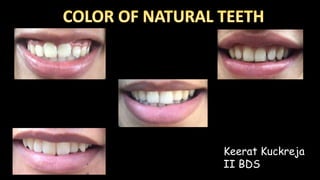
COLOR OF NATURAL TEETH
- 2. WHY DO WE NEED TO STUDY THE COLOR OF NATURAL TEETH? Recreate Form Shape and Color of teeth Communicate Accurate Details to the LAB Scientific Documentation and Record Universal Communication and expression
- 3. What is Color ? The quality of an object or substance with respect to light reflected by it. Usually determined visually by measureme nt of three properties: Hue , Chroma Value. It can also be define as a psychological response to a physical stimulus.
- 4. HUE • Dominant range of wavelengths that yields a perceived color. • It is the visual quality which distinguishes one family from the other CHROMA • Degree of saturation of a particular hue and measures the intensity of color • Degree of lightness or darkness of a color • Value of 0 = Black • Value of 10 = White VALUE
- 5. COLOR SYSTEMS MUNSELL COLOR SYSTEM CIELAB COLOR SYSTEM
- 6. Normal Teeth of a teenager with white stains Value of the teeth enhanced with Dental Bleaching
- 7. THE OPTICAL CHARACTERISTICS OF NATURAL TEETH METAMERISM OPALESCENSETRANSLUCENCY FLUORESCENCE
- 8. Metamerism • Objects that appear to be different colors when viewed in different light conditions • More opaque the ceramic --- more metamerism Color Corrected 5500k Incandescent source 2896K Flourescent source 4000K Translucency •Transmission and diffusion of light Conveys depth and vitality
- 9. Opalescence • It’s the ability of the object to appear • Blue or • red orange in reflected or transmitted light • Under direct illumination • Reflectance of short wavelengths( blue) • Absorption of long wavelength ( red orange) • Under Transillumination • Reflectance of long wavelength ( red orange) • Absortption of short wavelength ( blue) • Enamel is more opalescent than dentine
- 10. Flourescence • In fluorescent light , teeth absorb the energy and convert in to light with longer wavelength. • Tooth becomes an actual source of light. • It emits light of 400-450 nm.
- 11. SHADE MATCHING MEASUREMENT OF SHADE Hue Based Shade Tabs Value Based Shade Tabs Digital Colorimeters Shade matching softwares
- 12. Hue based shade guides Value based shade guides
- 14. DENTAL SHADE MATCHING SOFTWARES
- 15. REQUIREMENTS OF SHADE MATCHING • Use correct environment & lighting. • Shade selected at the beginning of appointments. • Patient should be sitting upright. • Dentist should be at a distance of at least 20 cm from teeth. • Patients teeth and dentist eyes should be at the same level.
- 16. Illumination & sources • Daylight ( 6500 K) • Variable depending the time of the day, cloud cover • Fluorescent tube lightings produce 5500°K light with CRI of 95%. • Tungsten/incandescent bulb—2800ºK - 3200ºK and a CRI of 100% Rite-Lite 2 offers three modes of light for shade taking: • Natural daylight at 5500 degreeK • Incandescent light (indoor) at 3200 degreeK • Ambient light (combination of indoor and outdoor light) at 3900 degreeK
- 17. Shade Determination Vita 3D Shade guide
- 20. Study of the most frequent natural tooth colors in the Spanish population using spectrophotometry • The study was based on the measurement of the natural tooth color of 1361 maxillary central incisors of Caucasian Spanish participants (671 men and 690 women) aged between 16 and 89 years and distributed homogeneously according to gender and age. All participants were asked to read and sign an informed consent form for participation in the study, which was approved by the Research Ethics Committee of the San Carlos Clinic (Madrid. One clinician (a woman of 30 with 8 years of experience, initials CGP) made the measurements with the same spectrophotometer (Easyshade Compact; Vita Zahnfabrik) with a standardized protocol for color evaluation.. All the participants were evaluated at the Department of Prosthodontics, School of Odontology, Complutense University of Madrid, Spain. • All recordings were made in the same room under fluorescent tubes with a luminescence intensity of between 1200 and 1500 lux. The upper central incisor has frequently been used to assess tooth color, as a representative of an individual's natural tooth color. The natural maxillary central incisors of the participants were healthy, with no restoration and no artificial whitening, and were cleaned before their color was measured. Before the recordings were made, a hygienic protector was placed on the probe tip (5 mm in diameter), and the lamp was calibrated. After calibration, the probe tip was placed in contact with and perpendicular to the middle third of the facial surface of the tooth. • Color was determined on the middle third of the tooth, which is the area that best illustrates tooth shade. Measurements were made in Single Tooth mode with Easyshade compact spectrophotometer). The color of the patient's clothes was neutralized with a gray cloth.. In order to determine the most frequent colors in the different age groups, the participants were recruited into three groups according to age: between 16 and 30 (young group), between 31 and 59 (middle-aged group), and above the age of 60 and up to a maximum of 89 (elderly group). These groups were subdivided according to gender. Most frequent colors in 3D master system Gender Men (n = 671) Women (n = 690) Age groups 16 - 30 years 31 - 59 years 60 - 89 years 16 - 30 years 31 - 59 years 60 - 89 years Shade tab (Percentag e) 1M1.5 (14.56%) 3M1 (10.13%) 4.5M1.5 (8.77%) 1M1.5 (21.66%) 2M1 (10.84%) 3M1 (9.82%) Shade tab (Percentag e) 1M2 (13.59%) 2.5L1.5 (5.91%) 4.5M2.5 (7.89%) 1M1 (13.82%) 2L1.5 (10.04%) 2.5L1.5 (5.80%) Shade tab (Percentag e) 1.5M1.5 (9.71%) 3.5L1.5 (5.06%) 3M1 (4.82%) 2L1.5 (10.14%) 3M1 (10.04%) 3.5M1 (5.36%
- 21. BIBLIOGRAPHY Philips Wikipedia IDT-Optical characteristics of natural teeth Vita 3D shade guide instructions Study of the most frequent natural tooth colors in the Spanish population using spectrophotometry Cristina Gómez-Polo, 1 Miguel Gómez-Polo,2 Juan Antonio Martínez Vázquez de Parga,2 and Alicia Celemín Viñuela2 JCD_Spring2016_ShadeWave.pdf VITA-Easyshade intructions www.shadewave.com